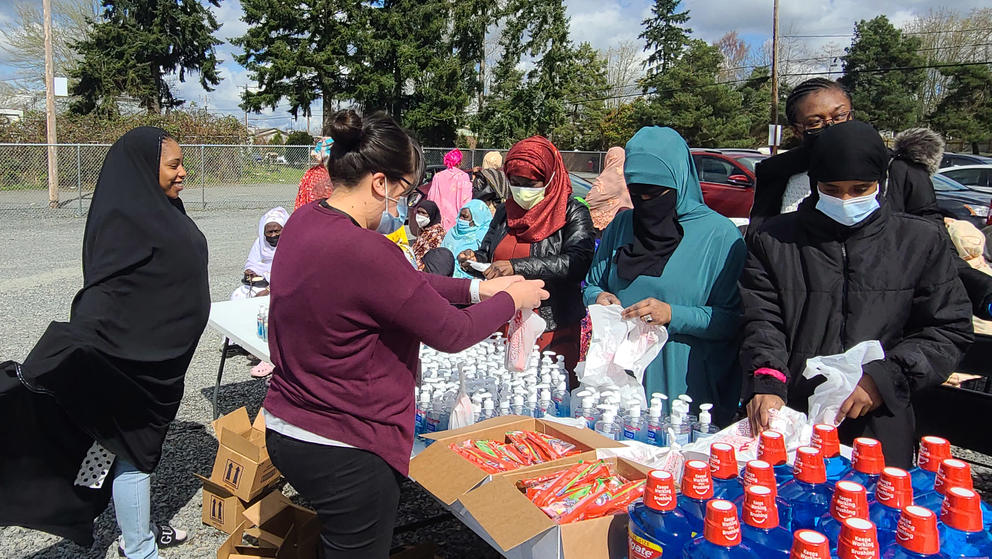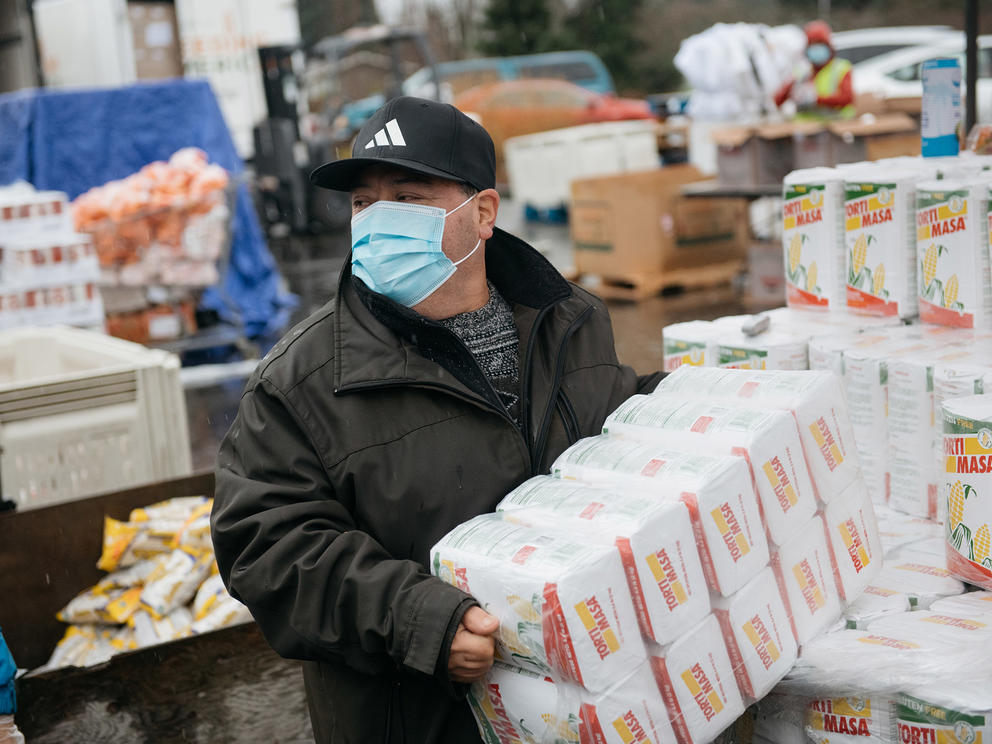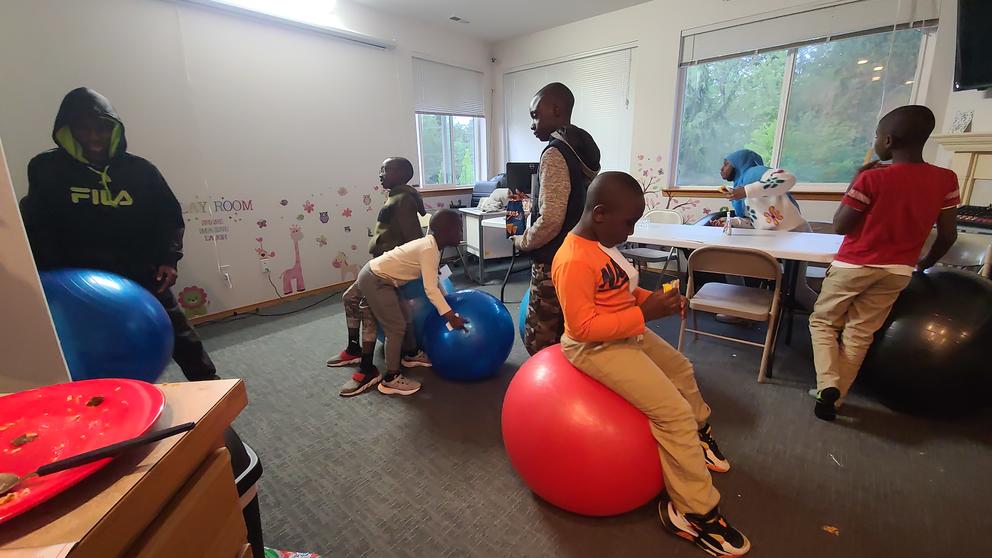"We consider ourselves the 211 for West Africans in the state,” he said, referring to the public service phone number that connects people with a variety of programs or supplies in their community. “[But] the demand for the services we provide at the center is much more than we can provide.”
Between service duties, Joof also needs to keep ahead of payroll, scheduling, rent and other operational costs. Throughout the pandemic, the center has benefited from a patchwork of community and government funding. But each grant has come with its own timeline and tangle of red tape.
With just two other employees, Joof said the center still struggles to find and apply for ongoing support from government recovery programs.
"I have one due today,” he said of a pending grant application, “but I'm not able to do it because I'm busy providing direct services.”
While small, grassroots nonprofits across Washington state have established vital links to vulnerable communities during the pandemic, many say they continue to face significant disadvantages when competing with larger legacy organizations for government recovery dollars or complying with complex spending rules.
A newly released statewide survey of nonprofits identified short application windows, late government payments, upfront matching dollars, complicated reporting requirements and other barriers that disproportionately exclude rural and Black, Indigenous and people of color-led organizations from funding. Larger nonprofits often have institutional resources for navigating the process.
“The current system is inequitable and results in communities not getting the local, culturally responsive services they need,” the survey report concluded. “It is also out of alignment with stated goals of government funders to reach BIPOC, rural, and other marginalized communities."
Some public agencies and nonprofit networks have started standing up new programs to help smaller groups build skills and resources, but nonprofit leaders say the system needs a more significant overhaul to meet community needs and alleviate the administrative burdens on recovery money.
"It's taking so much of my time,” Joof said. “It's overwhelming.”
Jose Ortiz grabs a stack of masa to put in a patron’s car at the Tri-Parish food bank in Burlington on Dec. 18, 2021. Ortiz said local partners helped the food bank secure food and financial support during the pandemic, but some funding ends in summer 2022 and he does not yet know how much money to count on after that. (Grant Hindsley for Crosscut)
Disproportionate challenges
Government agencies have increasingly outsourced social and humanitarian services to the nonprofit sector in recent decades, but the pandemic resulted in a historic surge in demand for relief programs across the country. Laura Pierce, executive director of Washington Nonprofits, said local organizations have seen unprecedented community need while also facing a tight labor market and the loss of many volunteers.
"That has been really, really challenging,” Pierce said. “You have a nonprofit sector that is so committed, continuing to do its work, but really tired, really exhausted.”
This story is a part of Crosscut’s WA Recovery Watch, an investigative project tracking federal dollars in Washington state.
Washington Nonprofits, an association of about 600 member organizations, last month released a survey on government contracting. More than 100 nonprofits, including 23 BIPOC-led and 30 rural organizations, shared their frustrations with government funding applications and compliance rules.
Two-thirds of responding nonprofits reported difficulty with application demands and deadlines. The survey said 59% found funding rules too complicated. More than half reported contracts did not adequately cover administrative costs or rising expenses over time. Many said short-term funding made hiring and planning a challenge.
Nonprofits that identified as Black, Indigenous, or people of color-led reported higher rates of difficulty with application procedures and timelines (74%), burdensome reporting requirements (70%) and contracts that do not cover administrative costs (70%).
"For smaller organizations, the burden of this process is not worth the funding received,” the survey report stated, “and it creates inequitable access barriers to small and BIPOC-led organizations."
Pierce said local and state government agencies often eat up much of the recovery spending timeline by developing specific program rules, drafting calls for proposals and reviewing applications — adding to the complexity of spending the money while also leaving a shorter window for delivering services.
"If it was just the federal compliance requirements, it wouldn't be that bad,” she said. "But the money comes down through the state and city ... and they've all added requirements at every level of government.”
Funding often requires nonprofits to detail line-item spending, use money within narrow windows, collect demographic data on clients, register with government portals, file reports on deliverables or provide other complex documentation. They may also require the applicants to have a significant amount of money on hand or insurance coverage to qualify.
Joof and other nonprofit leaders said relief contracts can also include unnecessary restrictions that prevent them from using their community experience to put dollars where they can do the most good. Nonprofits always have to build services around government priorities and on government timelines.
“Be flexible,” Joof suggested. “Give us leeway to do the things that are in line with our mission.”
Jose Ortiz, a regional network builder with Catholic Community Services and a volunteer at the Tri-Parish Food Bank in Skagit County, said local partners helped the food bank secure food and financial support, but some funding ends next month, and he does not yet know how much money to count on after that.
Such funding timelines can make long-term planning difficult, he said. Meanwhile, inflation has increased the costs of service at the food bank, which regularly serves 500 to 600 families.
"All the extra resources we got will soon be gone,” Ortiz said. “We're not sure what the future will hold.”
‘The grace is gone’
The Noble Foundation, a Vancouver-based nonprofit serving Clark and Cowlitz counties, partnered with local philanthropies early in the pandemic to obtain money for services under the Coronavirus Aid, Relief and Employment Security, or CARES, Act. Founder Ophelia Noble said the foundation did not have much staff at the time, but knew how to connect communities of color with rent assistance, vaccine clinics and other critical needs.
As government agencies rushed to get relief to the public, they worked to allow more flexibility on spending, Noble said. Officials also prioritized responsive support, relaxed some reporting demands and extended deadlines.
"It is very time intensive when you are a community-based, BIPOC-led, grassroots organization,” she said of the many requirements. "It's a lot of work.”
The foundation has since worked to build up its staffing and training for grant compliance, but Noble and others said additional barriers have started creeping back into the contracting process over the past year.
"The grace is gone,” said Virginia Prioleau, interim executive director of the foundation. “There are [now] strenuous requirements on the funding.”
Prioleau explained most government contracts also work on a reimbursement-based system that expects nonprofits to pay costs up front and then invoice the government for payment. Unlike larger nonprofits, smaller organizations cannot put up weeks or months of operational costs while waiting for payment.
"That is one of our major pain points,” she said, noting that the organization constantly weighs how invoice turnaround times may impact its budget.
The Washington Nonprofits survey found reimbursement-based contracts posed an outsized barrier to BIPOC-led organizations, as did contracts that did not include adequate money for covering administrative and reporting costs.
Noble said public agencies should move toward providing starting grants or at least shortening the turnaround on reimbursements, which can leave nonprofits hanging for weeks or months. She said she understands the importance of transparency on government spending, but the system should be reimagined to empower community-based nonprofits to do their best work.
"It's painfully obvious there are gaps,” she said.
Washington Nonprofits’ Pierce said some agencies still view outsourcing services to nonprofits as a potential cost-saving tactic that allows donors and volunteers to subsidize program expenses. Others sometimes undervalue nonprofit work as a hobby or charity instead of a career that often requires advanced degrees and unique skills.
“We kind of need to renegotiate that whole arrangement,” she said. “I think there's a basic disrespect for the nonprofit sector.”
Systemic inequities
In the King County Office of Equity and Social Justice, staffers say they have heard nonprofit partners share many of the same concerns about barriers outlined in the recent survey. Arun Sambataro, senior policy adviser and co-lead for federal grants, said small or grassroots nonprofits can quickly overextend themselves trying to meet demanding contracts.
“You’re stretched so thin already that it becomes incredibly difficult to operate,” she said. "Yet these are the community-based organizations that are the most connected and often can provide the most helpful services because they know what the community needs. They are deeply rooted in the community.”
Find tools and resources in Crosscut’s Follow the Funds guide to track down federal recovery spending in your community.
Larger, often white-led, organizations have established resources to hire staff, cover upfront costs, seek and apply for grants, keep up with reporting and still deliver the services on the contract. Sambataro said historic inequities often compound against newer organizations.
“Getting federal funding is really, really challenging,” she said, “and the smaller you are the harder it is; the more grassroots you are the harder it is. … This is a part of the landscape of structural racism.”
King County recently announced a $400,000 contract specifically for partners to help community-based organizations comply with the requirements of the federal relief grants they have received. Brooke McConnaughey, the office’s economic recovery and equity relations manager, said the office hopes the program will help up to 200 nonprofits in neighborhoods hit hardest by the pandemic.
The target nonprofits must have a budget of less than $2 million and fewer than 20 employees. McConnaughey said the program will offer up to 10 hours of technical assistance or operational development per organization, noting that time was based on feedback from other capacity-building programs.
"This is a first step of what needs to be an ongoing investment,” she said.
The Washington Nonprofits survey acknowledged that many organizations had benefited from increased funding availability during the pandemic and found many government officials understood their frustrations — though some said frontline officials often lacked the power to enact institutional improvements.
Nonprofit leaders like Joof and Noble said government agencies need to listen to input from community organizations and build systems that reflect their needs. Noble noted that the state Department of Commerce had taken proactive steps to reach out to BIPOC leaders and review the equity of its grant processes.
"We need to be at the table for our voices to be heard,” Joof said.
Pierce with Washington Nonprofits supported efforts to listen to smaller groups and help them grow administrative capacity, but voiced skepticism that short-term programs could build meaningful relationships.
Building that kind of capacity can take years. And community-based organizations will still burn bandwidth chasing grants and filing reports instead of providing direct services. The contracting survey report recommended shifting those burdens to intermediaries or eliminating many.
"More effective than teaching nonprofits how to jump through the many hoops associated with government contracting is the removal of hoops,” the report stated. “Applications and reporting should be streamlined and reduced to only what is truly necessary."
Seeking sustainability
When Joof first started what would be the Washington West African Center in 2017, he drove people to appointments in his private vehicle. He said he met with neighbors in parking lots to help them find services. Local support from the Community Foundation of Snohomish County and relief funding passed down through the Department of Health allowed the organization to open a location for the center in late 2020. They also received a donated passenger van.
“It took the pandemic and Black Lives Matter for us to get funding and be able to open an office,” he said. “[But] we need this. We can do this.”
The Group Health Foundation provided additional money for part of his payroll, but he said he does not have permanent funding for meal deliveries, the after-school program, senior social events, health clinics or the other services the center offers. He wants to build something sustainable, and then build some more.
(Disclosure: The Group Health Foundation provided funding for Crosscut’s Washington Recovery Watch.)
Noble said pandemic relief funding also allowed her Vancouver foundation to grow and help hundreds of people in southwest Washington. She fears those networks may erode as relief funding slows down. The needs for housing, health and other essential needs will not go away.
Catholic Community Services’ Ortiz said the demand at food banks will not stop when the money stops.
As the American Rescue Plan Act shifts many local funding decisions to city and county officials, Pierce said many governments have opted to use the money to backfill public reserves. She said she worries they may be missing their chance to really transform their communities by investing in local programs.
For his part, Joof has big plans — if he can pay for them. He said he wants to hire more staff and open offices in nearby counties, where he knows other immigrants need services. He wants a community center, a day care with a playground, maybe a soccer field and emergency short-term housing.
"This is our vision,” he said. “This is our dream."
Correction: A previous version of this story incorrectly stated the Washington West African Center bought its own passenger van. The van was donated by Community Transit.








